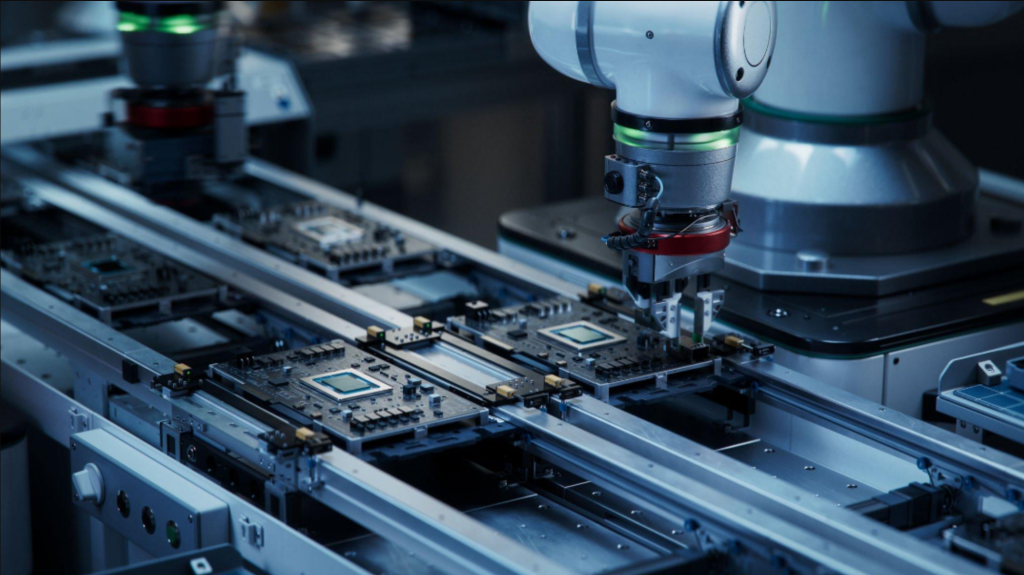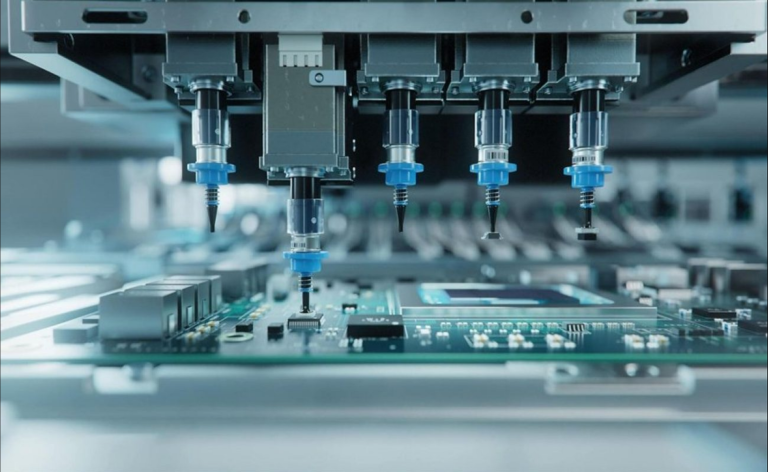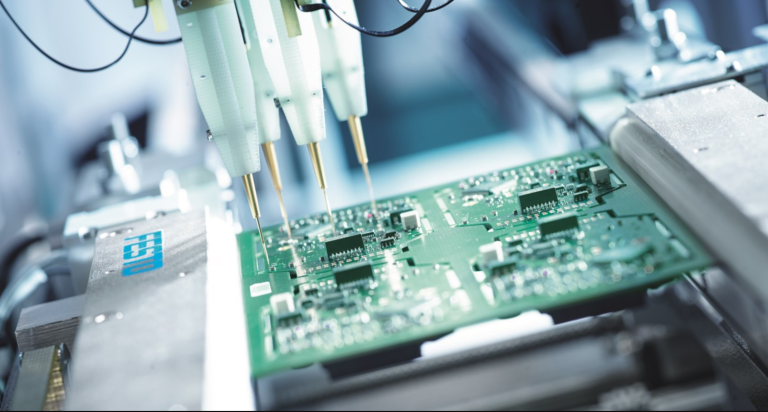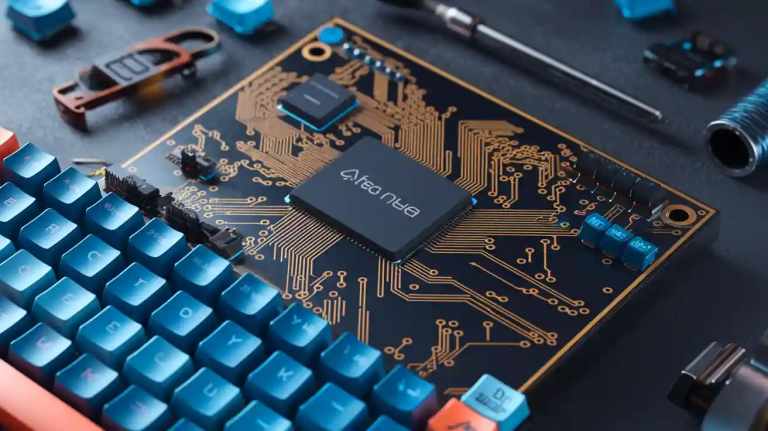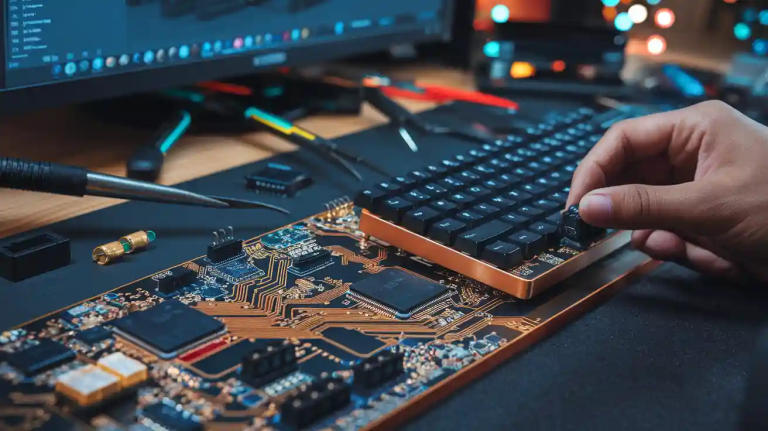Medical-grade PCBs play a vital role in modern healthcare technology. These specialized PCBs form the backbone of devices like ventilators, diagnostic tools, and implantable equipment. Adhering to standards and regulations ensures their safety and performance. For example, compliance with ISO 13485 enforces strict quality management systems, while the FDA mandates rigorous testing and documentation. These measures directly enhance the reliability of medical devices, which is critical for patient care. High-quality manufacturing processes also reduce the risk of device failure, ensuring consistent performance in life-saving applications.
Key Takeaways
- Medical PCBs are important for safe and reliable healthcare tools. They must follow strict rules like ISO 13485 and IEC 60601.
- Tracking parts in PCB making helps improve quality and safety. This is very important to keep patients safe.
- Following FDA rules and IPC standards makes sure devices are tested well. This lowers risks and helps patients get better care.
- Smaller PCBs with HDI make tiny medical tools possible. These tools work well without losing any features.
- Eco-friendly PCB designs are now more important. They use green materials and save energy to protect the planet.
Medical-Grade PCBs and Their Applications
Characteristics of medical-grade PCBs
Medical-grade PCBs are designed to meet the stringent demands of healthcare environments. They are compact, lightweight, and highly reliable, ensuring seamless functionality in critical medical applications. These PCBs undergo rigorous quality control processes to meet industry standards like ISO 13485 and IEC 60601-1. Traceability is another essential feature, allowing every component to be tracked from supplier to final assembly. Manufacturers also prioritize material selection, ensuring biocompatibility and the absence of contaminants. To maintain high performance, production occurs in controlled environments, minimizing the risk of contamination. Testing and validation further ensure that these PCBs meet electrical and environmental performance requirements.
Applications in diagnostic and monitoring devices
Medical-grade PCBs serve as the backbone of diagnostic equipment and patient monitoring devices. In diagnostic equipment like MRI and ECG machines, they enable precise data processing and signal integrity, ensuring accurate results. Portable diagnostic devices, such as those used for rapid blood analysis, rely on these PCBs for high accuracy and efficiency. Patient monitoring devices, including cardiac monitors, benefit from specialized PCB designs that enhance reliability and performance. These applications highlight the critical role of PCBs in advancing electro-medical applications and improving patient care.
| Application | Description |
|---|---|
| Portable diagnostic device | Rapid blood analysis with high accuracy, revolutionizing clinical testing. |
| Cardiac monitoring device | Improved signal integrity and reliability for better patient data. |
| MRI Machines | Essential for diagnostic precision in medical imaging. |
| ECG Machines | Vital for patient monitoring and assessment. |
Role in implantable and wearable medical devices
Implantable and wearable medical devices depend on high-quality PCB assembly to ensure safety and reliability. These devices, such as pacemakers and fitness trackers, require miniaturized PCBs that meet strict safety and quality standards. Biocompatibility is crucial for implantable devices, ensuring they function safely within the human body. Wearable devices, on the other hand, demand lightweight and compact PCBs to provide portability and comfort. By adhering to stringent regulatory standards, medical-grade PCBs significantly impact patient outcomes and device performance.
Standards and Regulations for Medical Printed Circuit Boards
ISO 13485 and quality management
ISO 13485 serves as the cornerstone for quality management in medical device manufacturing. This standard focuses on ensuring that processes meet the stringent requirements of medical-grade PCBs. By adhering to ISO 13485, you can establish a robust quality management system that prioritizes customer satisfaction and regulatory compliance. It emphasizes risk management, process control, and traceability, all of which are critical for medical printed circuit boards. For example, traceability ensures that every component in a PCB assembly can be tracked from its origin to the final product. This level of oversight reduces the risk of defects and enhances patient safety.
| Standard | Description |
|---|---|
| ISO 13485 | Focuses on quality management systems for medical devices. |
| ISO 9000 | Provides guidelines for quality in PCB design, production, and testing. |
| IEC 60601 | Ensures the safety and functionality of medical electrical equipment. |
IPC standards for PCB manufacturing
IPC standards play a vital role in defining the manufacturing requirements for PCBs. These standards ensure that medical-grade PCBs meet high-quality benchmarks for performance and reliability. For instance, IPC-A-600 outlines the visual quality criteria for printed circuit boards, while IPC-6012 specifies the performance and durability requirements for rigid PCBs. By following these guidelines, you can ensure that your PCB assembly meets the necessary electrical, thermal, and mechanical properties. IPC-A-610, another critical standard, provides detailed criteria for the cleanliness and soldering quality of electronic assemblies. These standards collectively enhance the reliability of diagnostic and monitoring devices.
| IPC Standard | Description | Focus Area |
|---|---|---|
| IPC-A-600 | Defines visual quality and acceptability criteria for PCBs. | Quality inspection |
| IPC-6012 | Specifies performance requirements for rigid PCBs. | Electrical, thermal, mechanical properties |
| IPC-A-610 | Details quality guidelines for electronic assemblies. | Assembly cleanliness and soldering |
FDA and medical device regulations
The FDA enforces strict medical device regulations to ensure the safety and effectiveness of medical-grade PCBs. These regulations, outlined in 21CFR820, govern the manufacturing processes and quality systems for medical devices. Compliance with FDA standards requires you to maintain detailed documentation, conduct rigorous testing, and implement robust quality control measures. For example, fda compliance mandates that all medical device manufacturing processes include risk assessments and validation procedures. This ensures that the final product meets the highest safety standards. By adhering to these regulations, you can enhance the reliability of your diagnostic devices and improve patient outcomes.
Tip: Staying updated on FDA requirements can help you streamline your compliance efforts and avoid costly delays in product approval.
IEC standards for safety and performance
The International Electrotechnical Commission (IEC) sets critical benchmarks for the safety and performance of medical printed circuit boards. These standards ensure that PCBs used in medical devices meet stringent requirements for reliability and patient safety. Among these, IEC 60601-1 stands out as a cornerstone standard. It establishes essential safety and performance criteria for medical electrical equipment, safeguarding both patients and operators. Similarly, UL 60601-1 emphasizes rigorous testing and validation processes to ensure that PCBs meet global safety standards.
| Standard | Description |
|---|---|
| IEC 60601-1 | Establishes general safety and essential performance standards for medical electrical equipment, ensuring reliability and safety for patients and operators. |
| UL 60601-1 | Focuses on safety requirements for medical electrical equipment, emphasizing the importance of thorough testing and validation of PCBs to meet safety benchmarks. |
Adhering to these safety standards minimizes risks associated with electrical malfunctions, ensuring the safety of medical electrical equipment. By following IEC guidelines, you can enhance the reliability and durability of your medical PCBs, which is crucial for maintaining compliance with medical device regulations.
Global compliance requirements
Meeting global compliance requirements is essential for manufacturers of medical printed circuit boards. These requirements ensure that devices meet international safety and quality benchmarks, enabling their use across different regions. Standards like ISO 13485 and IEC 60601-1 play a pivotal role in this process. ISO 13485 focuses on quality management systems, ensuring that medical devices are safe and effective. IEC 60601-1 sets safety and performance standards for medical electrical equipment, while IEC 62304 addresses software life cycle processes for medical device software.
| Standard | Description |
|---|---|
| ISO 13485 | Focuses on quality management systems specific to medical devices, ensuring safety and efficacy. |
| IEC 60601-1 | Sets safety and performance standards for medical electrical equipment, ensuring reliability. |
| IEC 62304 | Addresses software life cycle processes for medical device software, ensuring integrity. |
| UL 60601-1 | Governs safety requirements for medical electrical equipment, emphasizing patient safety. |
| IPC-6012 | Specifies requirements for rigid PCBs, ensuring durability and reliability in medical devices. |
Compliance with these global safety standards not only ensures the safety of medical devices but also facilitates their approval in international markets. By aligning your manufacturing processes with these standards and regulations, you can enhance the global reach and reliability of your medical PCBs.
Design Considerations for Medical Device PCB Assemblies
Reliability and durability in medical environments
Reliability and durability are critical when designing medical device PCB assemblies. Devices used in healthcare settings must operate flawlessly under demanding conditions. You need to ensure that the printed circuit boards meet stringent standards like ISO 13485 and IEC 60601-1. These standards emphasize quality management and safety, which are essential for maintaining device reliability.
To achieve high durability, you should focus on disciplined manufacturing processes. Key steps include thermal profiling and stencil design, which help maintain consistent quality during PCB assembly. Additionally, rigorous quality control measures, such as environmental monitoring and material selection, ensure that the PCBs can withstand harsh medical environments.
| Standard | Description |
|---|---|
| ISO 13485 | Ensures compliance with quality management systems specific to medical devices, impacting reliability. |
| IEC 60601-1 | Sets safety and performance benchmarks for medical electrical equipment, crucial for device reliability. |
| IPC-6012 | Outlines specifications for rigid PCBs, ensuring durability and reliability in medical applications. |
Biocompatibility and material selection
Biocompatibility is a non-negotiable requirement for medical PCB design, especially for devices that come into contact with the human body. Materials used in these PCBs must be free from contaminants to ensure safety and efficacy. For implantable devices, you must select materials that are compatible with the human body and resistant to sterilization processes.
When choosing materials, consider factors like operating temperature, signal types, and regulatory compliance. Advanced manufacturing technologies, such as sequential laminations and laser drilling, allow for precise material integration. These techniques ensure that the PCBs meet both functional and biocompatibility requirements. By prioritizing material selection, you can enhance the safety and effectiveness of your medical device PCB assemblies.
- Key considerations for material selection:
- Compatibility with sterilization methods.
- Resistance to environmental factors.
- Compliance with ISO 13485 and FDA regulations.
Traceability for regulatory compliance
Traceability is a cornerstone of regulatory compliance in medical PCB design. It ensures that every component in a PCB assembly can be tracked from its origin to the final product. This level of oversight is essential for meeting standards like ISO 13485 and FDA requirements.
To implement effective traceability, you should adopt robust tracking systems. These systems include component tracking, lot tracking, and serial number assignment. For example, component tracking allows you to trace individual parts back to their suppliers, while lot tracking monitors batches for quality assurance. Serial number assignment provides unique identification for each device, simplifying the process of recalls or audits.
- Component Tracking: Ensures every part can be traced back to its source.
- Lot Tracking: Monitors batches of components for quality assurance.
- Serial Number Assignment: Provides unique identification for each device.
By integrating traceability into your manufacturing processes, you can enhance quality control and ensure compliance with global regulatory standards.
Miniaturization and high-density interconnects
Miniaturization and high-density interconnects (HDI) have revolutionized the design of medical device PCB assemblies. As medical devices become smaller and more complex, you must prioritize compact and efficient PCB designs to meet these demands. Miniaturization allows you to integrate advanced functionalities into smaller devices, such as implantable pacemakers or wearable health monitors, without compromising performance.
HDI technology plays a critical role in achieving this. By using finer traces, microvias, and multiple layers, HDI PCBs enable higher component density and improved signal integrity. This is essential for devices requiring fast data processing and reliable performance, such as diagnostic imaging systems or portable monitoring equipment. For example, microvias allow you to connect multiple layers in a PCB assembly, reducing space while maintaining electrical performance.
Tip: Incorporating HDI technology in your designs can significantly enhance the functionality and reliability of compact medical devices.
Material selection is another key factor in miniaturization. You need to choose materials that support high-frequency signals and maintain biocompatibility. For implantable devices, materials must withstand sterilization processes and prolonged exposure to the human body. Advanced manufacturing techniques, such as laser drilling and sequential lamination, help you achieve precise designs while maintaining biocompatibility.
To ensure success, focus on rigorous testing and validation. Miniaturized PCBs must meet strict standards like ISO 13485 and IEC 60601-1 to ensure safety and reliability. By adopting these practices, you can create compact, high-performance medical devices that improve patient outcomes and meet regulatory requirements.
Challenges and Solutions in Meeting Standards
Common challenges in compliance
Meeting the stringent standards for medical PCBs often presents significant challenges. One common issue is navigating the complex regulatory landscape, which varies across regions. For example, compliance with ISO 13485, IEC 60601-1, and FDA regulations requires meticulous documentation and adherence to quality management systems. Manufacturers also face difficulties in managing electromagnetic interference (EMI), which can compromise the performance of diagnostic and therapeutic equipment. High production costs further complicate compliance, as advanced manufacturing technologies and rigorous testing protocols demand substantial investment.
Material obsolescence poses another challenge, especially for long-lifecycle products like patient monitoring devices. As regulations evolve, previously approved materials may no longer meet updated safety requirements. This necessitates constant vigilance and adaptability in material selection and design processes.
Solutions for design and manufacturing
Overcoming these challenges requires strategic approaches in design and manufacturing. Validating manufacturing methods ensures accuracy and safety in PCB assembly. For instance, you can implement environmental controls and test final assemblies to meet compliance standards. Facility approval processes, including periodic inspections, help maintain adherence to regulatory requirements.
To address EMI issues, you should isolate sensitive components and use shielding techniques. Strategic component placement and routing techniques, such as daisy chain configurations, enhance signal integrity and reduce interference. High-current paths benefit from polygon pours, which improve efficiency and reliability.
Investing in high-end equipment and quality control measures is essential for managing production costs. Advanced technologies like sequential laminations and laser drilling enable precise designs that meet both functional and regulatory demands. By adopting these solutions, you can streamline compliance efforts and enhance the reliability of your medical PCBs.
Importance of testing and validation
Testing and validation are critical for ensuring the safety and performance of medical PCBs. Quality control measures, such as traceability and material selection, play a pivotal role in meeting regulatory standards. For example, traceability systems allow you to track components from suppliers to the final product, ensuring comprehensive documentation.
Environmental controls during manufacturing prevent contamination, while rigorous testing protocols verify electrical and environmental performance. These tests confirm that the PCBs meet the specifications required for diagnostic and therapeutic equipment. By prioritizing testing and validation, you can ensure that your PCB assembly delivers consistent performance in medical applications.
Note: Integrating tools for documentation and testing not only simplifies compliance but also enhances long-term reliability, especially for products with extended lifecycles.
Future Trends in Medical Device Regulations and Standards
Emerging technologies and their influence
Emerging technologies are reshaping the landscape of medical device regulations and standards. As devices become more advanced, regulatory bodies are adapting guidelines to address new risks and opportunities. For instance, the FDA plans to regulate laboratory-developed tests (LDTs) as medical devices by 2025, introducing stricter compliance requirements for clinical tests.
| Year | Regulatory Change | Impact on Standards |
|---|---|---|
| 2025 | FDA regulating laboratory-developed tests (LDTs) | New compliance requirements for clinical settings |
Technological advancements like miniaturization and integration are driving the development of smaller, more powerful PCBs for portable medical applications. High-frequency PCBs are enhancing imaging technologies, while flexible and stretchable PCBs are enabling wearable health devices. These innovations demand updated standards to ensure safety and reliability in increasingly complex systems.
Sustainability in medical PCB design
Sustainability is becoming a critical focus in medical PCB manufacturing. You can adopt user-centered designs to minimize unnecessary components and reduce resource usage. Durable designs also extend product lifecycles, decreasing the need for repairs or replacements.
Eco-friendly materials like biodegradable polymers, such as PLA and PHA, are replacing traditional plastics to reduce environmental impact. Energy-efficient electronics optimize battery life, while reusable and modular components support individual part replacements, minimizing waste.
- Key trends in sustainable PCB design:
- Energy-harvesting technologies for self-powered devices.
- Use of eco-friendly materials to reduce landfill waste.
- Lifecycle awareness for environmentally responsible manufacturing.
By prioritizing sustainability, you can align with greener healthcare practices while meeting evolving regulatory expectations.
AI and automation in compliance processes
AI and automation are revolutionizing compliance processes for medical devices. Real-time monitoring powered by AI allows you to identify risks and regulatory violations before they escalate. This proactive approach minimizes delays in product approval and reduces the risk of penalties.
Regulatory bodies like the FDA are recognizing AI’s potential in risk management. AI enhances transparency and traceability, ensuring that your practices align with current and future standards. For example, automated systems can track every component in a PCB assembly, simplifying audits and improving documentation accuracy.
- Benefits of AI in compliance:
- Early detection of regulatory risks.
- Improved traceability and documentation.
- Enhanced alignment with evolving safety standards.
By integrating AI into your compliance processes, you can streamline operations and maintain a competitive edge in the rapidly evolving medical device industry.
Adhering to standards and regulations for medical-grade PCBs is essential for ensuring safety and reliability in healthcare technology. Strict guidelines, such as IEC 60601, protect patients and healthcare providers by minimizing risks associated with medical devices. Compliance with ISO 13485 supports lifecycle management, ensuring devices maintain their efficacy over time. These measures not only safeguard users but also enable manufacturers to meet global benchmarks.
Standards evolve to keep pace with advancements in healthcare technology. This evolution fosters innovation, allowing you to design safer, more efficient devices. By embracing these changes and integrating cutting-edge solutions, you can address future challenges while maintaining compliance. A systematic approach to quality management ensures that medical-grade PCBs continue to advance patient care and improve outcomes.
Note: Innovation in PCB design, coupled with adherence to safety standards, is key to driving progress in modern healthcare.
FAQ
What makes medical-grade PCBs different from standard PCBs?
Medical-grade PCBs are designed to meet stricter safety, reliability, and biocompatibility standards. They undergo rigorous testing and comply with regulations like ISO 13485 and IEC 60601-1. These PCBs also feature advanced materials and manufacturing processes to ensure performance in critical healthcare applications.
Why is traceability important in medical PCB manufacturing?
Traceability ensures that every component in a PCB can be tracked from its origin to the final product. This is crucial for meeting regulatory requirements like ISO 13485 and FDA standards. It also simplifies audits, recalls, and quality control, enhancing patient safety and product reliability.
How do IPC standards impact medical PCB quality?
IPC standards define the manufacturing and quality benchmarks for PCBs. Standards like IPC-A-600 and IPC-6012 ensure that medical PCBs meet strict criteria for durability, cleanliness, and performance. Following these guidelines helps you produce reliable devices that comply with global regulations.
What challenges do manufacturers face in meeting medical PCB standards?
Manufacturers often struggle with complex regulations, high production costs, and material obsolescence. Navigating standards like ISO 13485 and FDA requirements demands meticulous documentation and testing. Advanced manufacturing technologies and strategic design approaches help overcome these challenges.
How does miniaturization benefit medical device PCBs?
Miniaturization allows you to create compact, lightweight devices like wearables and implantables without sacrificing functionality. High-density interconnects (HDI) and advanced materials enable smaller designs with improved performance. This innovation supports the development of portable and efficient medical technologies.
Tip: Focus on HDI technology and rigorous testing to ensure miniaturized PCBs meet safety and performance standards.




